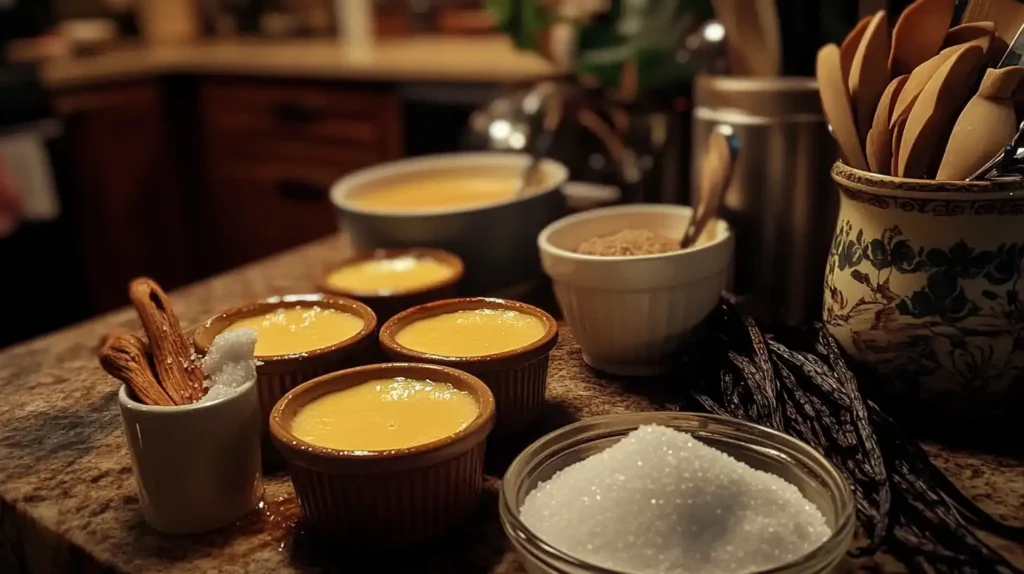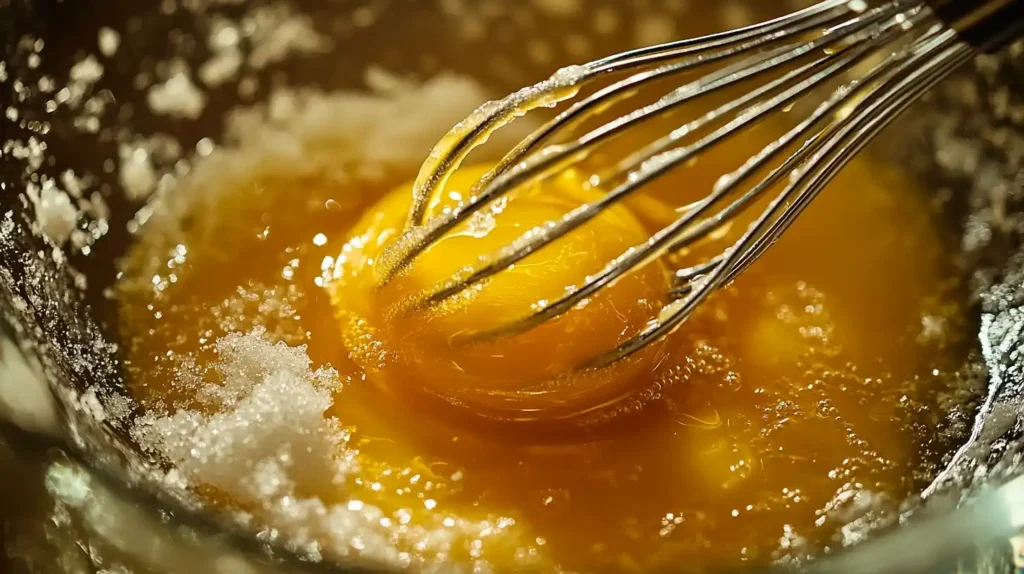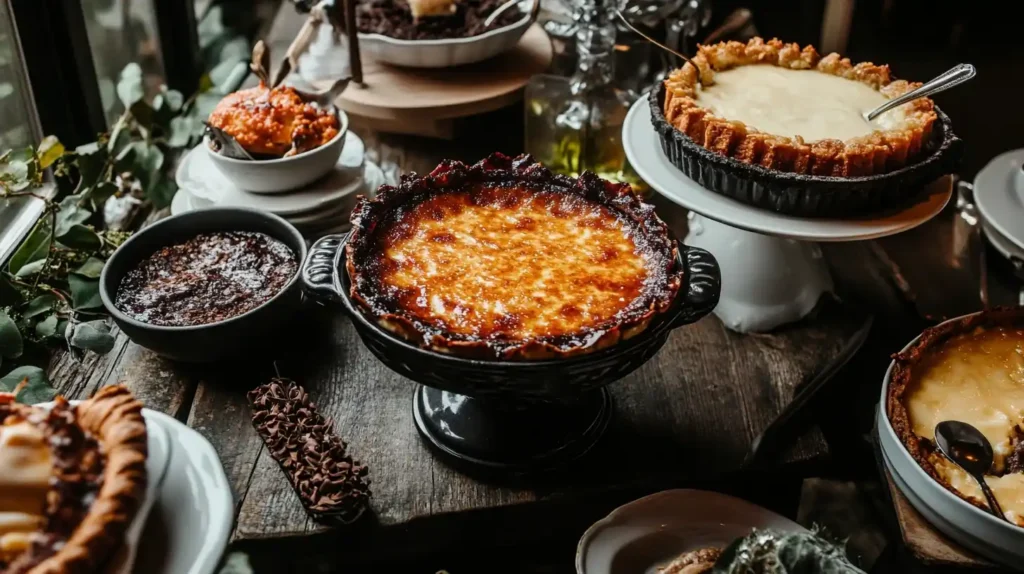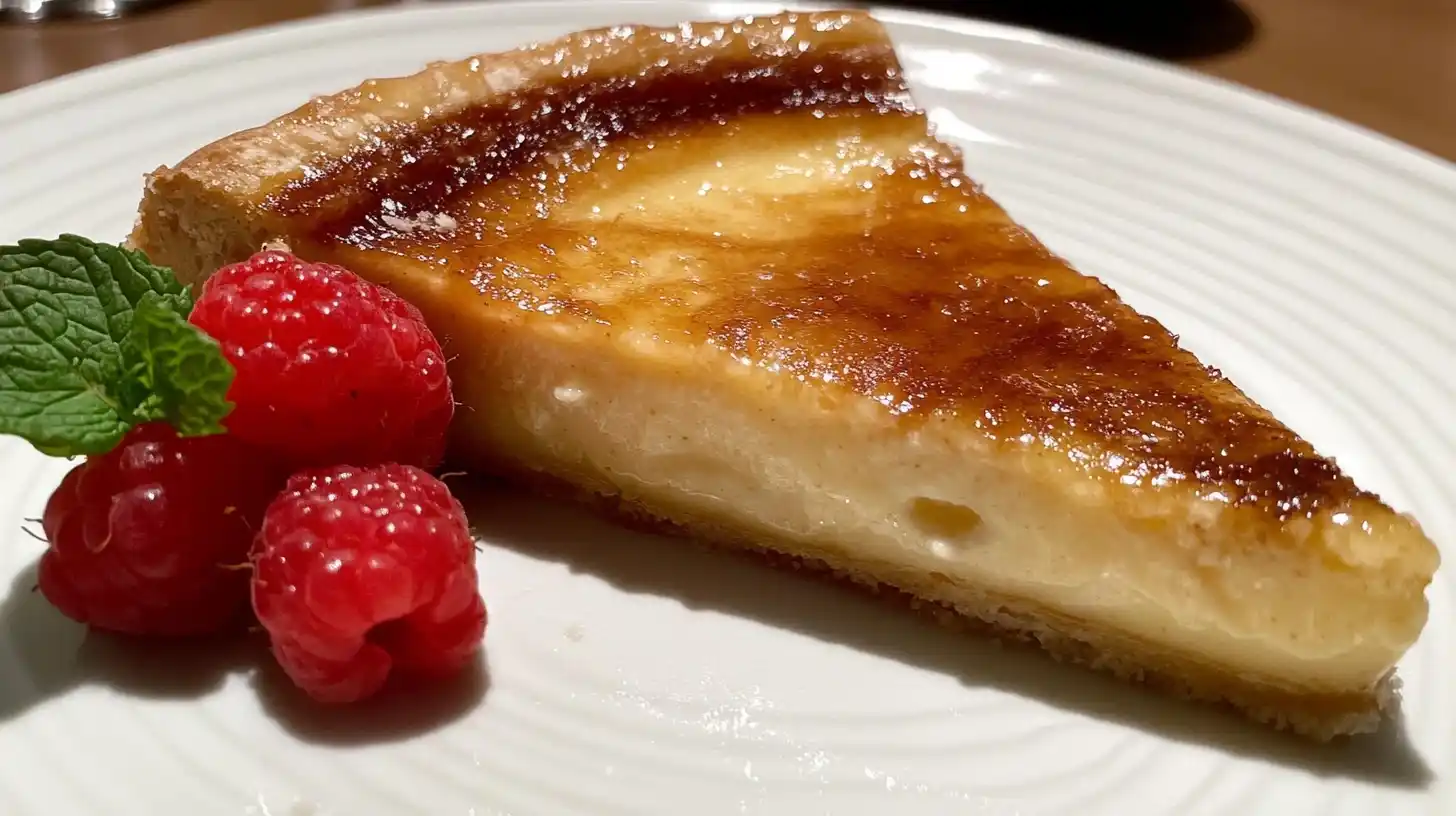Crème brûlée is a well-loved dessert with its smooth custard base and crunchy caramelized sugar top. This French classic is perfect for those who love a balance of creamy and crisp textures. But have you ever wondered what makes this dessert so special? Let’s explore the simple ingredients and techniques that bring crème brûlée to life.
Table of contents
- What Is Crème Brûlée? A Classic Crème Brûlée Overview (classic crème brûlée)
- Brûlée Ingredients – What Is Crème Brûlée Made Of? (brûlée ingredients, custard dessert ingredients)
- The Science Behind Crème Brûlée
- How to Make Crème Brûlée Step-by-Step
- Variations of Brûlée
- FAQs About Crème Brûlée
- Common Mistakes to Avoid in a Crème Brûlée Recipe ( crème brûlée recipe )
- Serving and Storing Crème Brûlée: Tips for Enjoying Your Brûlée Dessert (brûlée dessert)
- Conclusion
What Is Crème Brûlée? A Classic Crème Brûlée Overview (classic crème brûlée)
Crème brûlée is a French dessert that features a silky custard base made from heavy cream, egg yolks, sugar, and vanilla. Topped with caramelized sugar, the dessert is served slightly chilled, allowing the contrasting textures and flavors to shine.
For those who love experimenting in the kitchen, recipes like this one often pair well with unique spins, such as the savory twist seen in the Crab Brûlée Recipe. This can offer inspiration for flavor creativity.
This dessert is often served slightly chilled, which enhances its creamy texture and balances the sweetness of the caramelized sugar. Many people associate crème brûlée with fine dining, but it’s surprisingly simple to make at home.
Historically, it dates back to European traditions. Similar desserts, such as Spain’s Catalan cream, also feature a custard base with a caramelized topping. You can learn more about its fascinating history and origins by visiting Origins of crème brûlée.
Brûlée Ingredients – What Is Crème Brûlée Made Of? (brûlée ingredients, custard dessert ingredients)
The ingredients for crème brûlée are simple, but each one is crucial to its success. Here’s what you’ll need:

- Heavy Cream: This is the main ingredient that gives the custard its rich, silky texture. It’s best to use full-fat cream, but you can substitute it with coconut cream for a dairy-free option.
- Egg Yolks: Egg Yolks: They thicken the custard and contribute to its richness. Be sure to separate the yolks carefully, as any egg whites can affect the texture.
- Sugar: Sugar plays a double role here. It enhances the custard’s sweetness and forms a caramelized topping. Use fine granulated sugar for the best results, as it melts evenly.
- Vanilla: Vanilla adds a warm, aromatic flavor. You can use vanilla extract, paste, or even fresh vanilla beans for an extra touch of luxury.
- Optional Ingredients: A small pinch of salt can enhance the flavors, while ingredients like coffee, matcha, or citrus zest can be added for unique variations.
For more tips on achieving the perfect caramelized sugar crust, explore Techniques for caramelizing sugar.
The Science Behind Crème Brûlée
The success of crème brûlée relies on the interplay of science and technique. Every ingredient and step in the process contributes to the dessert’s silky texture and crispy top.
- Custard Setting: The egg yolks thicken the custard through a process called coagulation. When gently heated, the proteins in the yolks form a network that traps the cream, creating the smooth consistency we all love.
- Water Bath: Baking the custard in a water bath ensures gentle, even heat distribution. This prevents the eggs from cooking too quickly, which could cause curdling or cracks in the custard.
Just like soaking French fries in water before frying helps achieve the perfect crisp texture, using a water bath when baking crème brûlée ensures an evenly cooked, silky custard. Learn more about why soaking fries in water is crucial for texture and taste in this guide: Why Do You Soak French Fries in Water Before Frying? - Caramelization: The caramelized sugar topping results from the Maillard reaction. When sugar is heated, its molecules break down and reorganize into a hardened, golden crust with deep, complex flavors.
These techniques might sound tricky, but with practice, they become easy to master. The final dessert is both sophisticated and satisfying.
How to Make Crème Brûlée Step-by-Step
Creating crème brûlée at home may seem intimidating, but it’s simpler than you think. Just follow these easy steps for a perfect dessert every time.

1. Prepare the Custard
- Heat 2 cups of heavy cream in a saucepan over medium heat until it’s warm but not boiling. Add a teaspoon of vanilla extract or scrape in the seeds from a vanilla bean for authentic flavor.
- In a mixing bowl, whisk together 5 large egg yolks and ½ cup of sugar until the mixture turns pale yellow and slightly thick.
- Gradually pour the warm cream into the egg mixture while whisking continuously. This process, known as tempering, prevents the eggs from cooking too quickly.
2. Bake the Custard
- Strain the custard through a fine mesh sieve to remove any lumps.
- Divide the custard evenly into 4 to 6 ramekins. Set the ramekins in a baking dish and add hot water until it reaches halfway up their sides.
- Bake in a preheated oven at 325°F (163°C) for 35–40 minutes, or until the edges are set but the center is still slightly jiggly.
3. Chill the Custard
- Take the ramekins out of the water bath and let them cool to room temperature. After that, chill them in the refrigerator for a minimum of 4 hours or overnight. Chilling allows the custard to fully set and enhances the flavor.
4. Caramelize the Sugar
- Sprinkle a thin, even layer of sugar over the top of the custard. Use about 1–2 teaspoons of sugar per ramekin.
- With a kitchen torch, melt the sugar until it forms a golden-brown crust. If you don’t have a torch, place the ramekins under a broiler for a minute or two, watching closely to avoid burning the sugar.
Your crème brûlée is now ready to enjoy!
Variations of Brûlée
While the classic crème brûlée recipe is timeless, there are plenty of ways to customize this dessert to suit your taste or dietary needs. Here are some popular variations:
1. Flavored Custards
- Chocolate Crème Brûlée: Replace part of the cream with melted dark chocolate for a rich, indulgent twist.
- Coffee-Infused Brûlée: Steep ground coffee in the cream before preparing the custard for a bold, aromatic flavor.
- Citrus Zest: Add the zest of an orange or lemon for a refreshing and zesty profile.
While traditional crème brûlée is flavored with vanilla, experimenting with herbal flavors like basil can create a unique twist. Some Italian-inspired desserts even incorporate basil-infused cream, much like how restaurants such as Olive Garden use basil pesto in their dishes. Does Olive Garden Have Basil Pesto? Find out here.
2. Dietary-Friendly Options
- Non-Dairy Crème Brûlée: Substitute coconut cream or almond milk for heavy cream. Adjust the sweetener for taste.
- Low-Sugar Version: Use natural sweeteners like erythritol or stevia for a healthier option without compromising on taste.
3. Regional Twists
- Matcha Crème Brûlée: Add a teaspoon of matcha powder to the custard for a unique, earthy flavor.
- Spiced Brûlée: Infuse the cream with spices like cinnamon, cardamom, or cloves for a warm, comforting dessert.
4. Toppings and Additions – Enhancing Your Brûlée Dessert (brûlée dessert)
- Fresh Fruits: Serve with berries, figs, or citrus slices for added freshness.
- Nutty Layers: Sprinkle chopped nuts like pistachios or almonds on top of the caramelized sugar for extra crunch.
These variations can elevate the classic dessert into something uniquely yours, offering new experiences for your palate.

FAQs About Crème Brûlée
Once your crème brûlée is ready, the final step is presenting and storing it properly to maintain its quality and appeal. Here are some tips to ensure the best results:
Serving Tips
- Timing: Serve crème brûlée immediately after caramelizing the sugar. The contrast between the cool custard and warm sugar crust is at its peak when freshly prepared.
- Enhance Presentation: Garnish with fresh berries, mint leaves, or a dusting of powdered sugar for an elegant touch.
- Pairings: Pair this dessert with a cup of coffee, tea, or even sparkling water to cleanse the palate.
Storing Leftovers
- Refrigeration: Cover the ramekins with plastic wrap and store them in the fridge for up to 2 days. Avoid covering them too tightly, as this can soften the caramelized topping.
- Avoid Freezing: Freezing is not recommended as it can compromise the custard’s texture, making it grainy when thawed.
Re-Caramelizing
If the sugar topping softens in storage, simply add a fresh layer of sugar and re-caramelize with a torch or under the broiler before serving again.
Common Mistakes to Avoid in a Crème Brûlée Recipe (crème brûlée recipe)
Making crème brûlée at home is easier than it seems, but a few common mistakes can impact the final result. Avoid these pitfalls to ensure your dessert is as perfect as it looks in a professional patisserie.
1. Overcooking the Custard
- Problem: Baking the custard too long or at too high a temperature can cause it to curdle or develop cracks.
- Solution: Bake the custard until the edges are set but the center is still slightly jiggly. Use a water bath to maintain gentle, even heat, and check frequently toward the end of the baking time.
2. Skipping the Water Bath
- Problem: Baking the custard without a water bath often results in uneven cooking, leading to a grainy texture.
- Solution: Always place the ramekins in a baking dish and pour hot water around them until it reaches halfway up the sides. This ensures smooth and silky custard every time.
3. Using Too Much Sugar for Caramelizing
- Problem: A thick layer of sugar can burn easily and overpower the custard’s flavor.
- Solution: Use a thin, even layer of sugar about 1–2 teaspoons per ramekin. Shake the ramekin gently to distribute the sugar evenly before caramelizing.
4. Overheating the Sugar
- Problem: Caramelizing the sugar for too long can lead to a burnt, bitter crust.
- Solution: Use a kitchen torch to caramelize the sugar evenly, keeping the flame moving in small circles. If using a broiler, keep the ramekins under close watch and remove them as soon as the sugar turns golden brown.
5. Not Straining the Custard Mixture
- Problem: Skipping this step can result in lumps or bubbles in the custard.
- Solution: Always strain the custard through a fine mesh sieve before pouring it into the ramekins. This removes any egg solids or air bubbles for a smooth, creamy texture.
6. Not Allowing the Custard to Chill Properly
- Problem: Serving crème brûlée without sufficient chilling time can lead to a runny custard.
- Solution: Refrigerate the custards for at least 4 hours, or overnight if possible. Chilling allows the custard to set fully and enhances the flavor.
7. Using Low-Quality Ingredients
- Problem: Inferior cream, vanilla, or eggs can impact the dessert’s flavor and texture.
- Solution: Use high-quality cream and fresh eggs. If possible, opt for real vanilla beans or pure vanilla extract for the best taste.
8. Improper Storage of Leftovers
- Problem: Covering the custard tightly can cause the sugar topping to lose its crunch.
- Solution: Store leftovers loosely covered and re-caramelize the sugar before serving.
By keeping these mistakes in mind and taking steps to avoid them, you’ll create a flawless crème brûlée every time.
Serving and Storing Crème Brûlée: Tips for Enjoying Your Brûlée Dessert (brûlée dessert)
Crème brûlée is a dessert that shines not only because of its taste but also due to its visual appeal. Presenting it beautifully and storing it properly can make a significant difference in the overall experience. Below are detailed tips to help you serve and store this classic dessert effectively.
Serving Tips for a Classic Crème Brûlée (classic crème brûlée)
1. Serve Immediately After Caramelizing the Sugar
The perfect crème brûlée offers a delightful contrast between the cold, creamy custard and the warm, crispy sugar topping. To enjoy this, serve it right after caramelizing the sugar. Over time, the sugar topping may lose its crunch as it absorbs moisture from the custard.
2. Enhance the Presentation
Presentation matters, especially for a dessert as elegant as crème brûlée. You can elevate its appearance with simple yet striking additions:
- Top each ramekin with a few fresh berries, such as raspberries, blueberries, or strawberries, to add a pop of color.
- Garnish with a sprig of fresh mint for a refreshing look and aroma.
- Dust lightly with powdered sugar for a professional, polished finish.
3. Pairing Suggestions
Crème brûlée pairs well with a variety of beverages and accompaniments:
- A rich espresso or latte complements its creamy texture.
- A light herbal tea, like chamomile, balances the dessert’s sweetness.
- Sparkling water or prosecco can cleanse the palate between bites, enhancing the overall experience.
Storing Leftovers Safely
If you have leftover crème brûlée, storing it properly is essential to maintain its taste and texture. Follow these steps for the best results:
1. Refrigeration
- Place the ramekins in the refrigerator, and cover them loosely with plastic wrap. Avoid pressing the wrap directly onto the sugar crust to prevent it from softening.
- Properly stored, the custard can last up to 2 days in the refrigerator.
2. Avoid Freezing
Freezing crème brûlée is not ideal because the freezing and thawing process can break down the creamy custard, making it grainy or watery. If you must freeze it, do so before caramelizing the sugar. When you’re ready to serve, thaw the custard in the refrigerator and caramelize the sugar topping fresh.
Re-Caramelizing the Sugar Topping
If the sugar topping softens during storage, don’t worry, it’s easy to restore its crunch. Simply:
- Gently dab the custard surface with a paper towel to absorb any moisture.
- Add a fresh, even layer of sugar on top.
- Use a kitchen torch or broiler to caramelize the sugar again until it forms a golden crust.
This method ensures the dessert looks and tastes as good as when it was first made.
Conclusion
Crème brûlée is a dessert that beautifully combines simplicity with sophistication. With just a handful of basic ingredients—heavy cream, egg yolks, sugar, and vanilla—this classic French treat becomes a luxurious experience for the senses. Its silky custard and crisp caramelized sugar topping create a delightful contrast that makes it a favorite worldwide.
Mastering crème brûlée may seem daunting at first, but with the right techniques, it’s surprisingly easy to make at home. By avoiding common mistakes, exploring creative variations, and serving it with flair, you can impress guests or enjoy it as a personal indulgence.
Whether you stick to the timeless recipe or experiment with unique flavors like matcha or coffee, crème brûlée offers endless possibilities. Now that you know what brûlée is made of and how to perfect it, you’re ready to turn your kitchen into a gourmet patisserie.
So, grab your ramekins, a torch, and a few simple ingredients your homemade crème brûlée adventure awaits!

